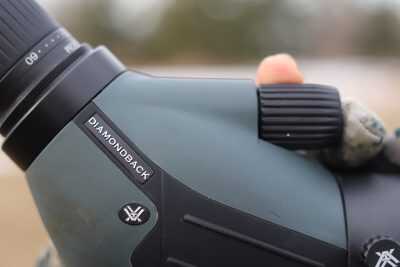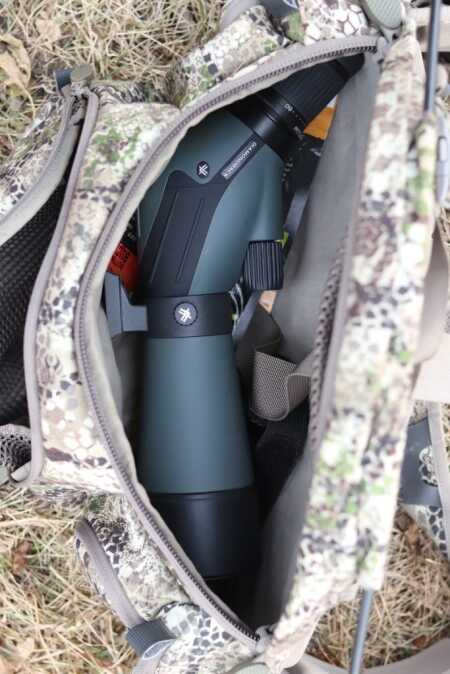The Diamondback promises big performance in a small package, but did Vortex deliver on this economical spotting scope?
Testing the Diamondback
Hunting the spacious prairie of South Dakota often mean that the game you’re after can be miles away. Because of that, good glass is a necessity to see if the pursuit is worth the effort of closing the distance. In these situations, a spotting scope shines when your binoculars have reached the end of their rope. I used the Vortex Diamondback 20x60x60 for a season’s worth of tags in the Rushmore State, chasing whitetails in the southeast, waterfowl in the northeast, mulies in the northwest, and elk in the southwest. It quickly became a favorite piece of gear that made an appearance on every hunt.
 SPECS:
SPECS:
- Magnification | 20-60x
- Objective Lens Diameter | 60 mm
- Linear Field of View | 114-51 feet/1000 yards
- Angular Field of View | 2.2-1 degrees
- Close Focus | 20 feet
- Eye Relief | 17-14 mm
- Exit Pupil | 3-1 mm
- Length | 14 inches
- Weight | 33.8 ounces
- MSRP: $500
 Best Features
Best Features
The Diamondback series is one of Vortex’s most popular, with the spotting scope having brethren in the rifle scope and binocular family as well. As with the entire Diamondback series, Vortex has aimed to create an economical optic that brags of performance and durability.
On the durability note, this is often an overlooked part of having quality optics. Most envision that they’ll treat their new binoculars or scope with utmost care, thinking that it’ll never feel a bump or bruise. However, that’s not the case in real-world hunting scenarios.
Durability
My Diamondback Spotting Scope spent about a month riding in the backseat of my pickup in case I needed to quickly access it to glass up a buck. From October to January, with repeated use and plenty of bumps and bruises, the scope performed the same all season just as it did out of the box. If you do mess up, though, Vortex offers lifetime warranties that are hassle-free to deal with, no matter whose fault it is, how it happened, or where you purchased it.
As for the performance itself, the scope was top notch. It does its best work in the magnification range of 20-40X, providing sharp images that allowed me to do things like count the exact points on a buck, identify the different species of duck from across a lake, and scan for collars on a large herd of distant elk. It did well in low-light, which is when you’ll be counting on it most, and never fogged up, even when temps dipped below freezing.
What might be most likable about the Diamondback is its size. While 14 inches is very impressive for a spotting scope of this magnification, the weight of just 33.8 ounces is outstanding. Some scopes that go to 60x literally weigh twice as much, with most of them falling in the 40-60 ounce range. This is a big deal when you’re considering the burden of hauling a spotting scope around in your backpack on a hunt, but Vortex makes it an easy decision with the efficient design.
The dials on the scope performed as expected, and were hardly noticeable on any hunts (which is a good thing). The focus and magnification were always responsive, yet smooth. This is something you typically don’t appreciate until it doesn’t work like it should.
Some Negatives
The list of dislikes for the Diamondback is short. One gripe is that it often struggled at long distances when the sun was high, showing heat waves across the landscape that created a mirage effect. It should be noted that this is problematic for nearly all spotting scopes, and will give users fits even as you pay twice as much.
Also, at the higher powers, the scope didn’t offer the greatest imagery. Things would have the tendency to be blurrier or over-exposed, but it was never enough to be an inconvenience. For example, I could easily pick up on the frame size of deer at great distances to know if they were shooters or not, but couldn’t always get the finer details like brow size.
Bottom Line
For $500, this is one of the most feature-rich spotting scopes on the market at that price point. It easily punches above its weight class with glass quality and durability, and it can’t be stressed enough how remarkable its size is. This is ideal for those who love firearms, whether you’re looking use it for a day at the range, a weekend on the mountain, or just to keep it under your pickup’s passenger seat.
For more information about Vortex optics, click here.
To purchase Vortex optics on GunsAmerica, click here.

First, mirage. Mirage is an atmospheric effect that has nothing to do with the scope. The higher the magnification, the worse any given amount of mirage will look. I\’d say you should compare apples to apples (identical mirage conditions using the same magnification in scopes side-by-side), but it\’s a fool\’s errand looking for a difference in how a scope deals with mirage because there is no difference. The mirage is what it is, all scopes must look through the atmosphere at a target. If the air is disturbed, you will see that disturbance through the scope and higher magnifications will make it more pronounced. (Your eyes see it too, but it\’s not as much of a problem because your eyes are 1X.)Second, \”over-exposed\”? Not possible. Bloom or lens flare (if looking close to a bright light, like the sun and caused by internal reflections causing \”stray light\” inside the scope) might cause an image to go hazy and bright, but the amount of light any scope takes in is limited by its objective lens. After that the amount of the light that reaches the eye is always a function of build quality (loss of light due to reflection off internal elements because of substandard coatings) and magnification (magnification decreases the size of the exit pupil and spreads the light that entered the front element \”thinner\”). As you increase magnification, the image will always get dimmer (although not necessarily perceptible because under most conditions the eye will adjust – only in darker conditions will the darkening through the scope be noticeable as the light level reaches the limits of the eye\’s ability to adjust). Manufacturers strive to deliver the most light an optical system is capable of delivering to the user\’s eye. A scope that got brighter (\”over exposure\”) as you increased it\’s magnification would be something akin to magic. If an optic doesn\’t deliver too much light to the eye at it\’s lowest magnification, there\’s no way it can deliver MORE light as the magnification increases. That\’s against the rules of the physics of an optical system. (Nearly all common optical devices – except eyeglasses and contact lenses – gather more light than the human eye. But then they almost all give a magnified view, and this means only a fraction of the light collected is delivered to the eye. So unless you look at something extraordinarily bright, you\’d rarely notice an INCREASE in brightness through a scope or binocular. For example, look at the sun for an instant through a scope and you can do permanent damage to your eye. Look at the full moon through binoculars and it may cause you to wince because it is so much brighter than your surroundings, the lower light level of which your eyes have adapted to. Even in a perfect optical system, the amount of light available to the user\’s eyes is limited by the diameter of the objective lens and the level of magnification – aka \”focal length\”. The two numbers give you an optic\’s \”f stop.\” A lower f stop is delivers a brighter image, a larger f stop number means the image is dimmer. This is why in photography, as you increase the f stop – decrease the size of the aperture or zoom in without adjusting the aperture – a longer exposure time is necessary to balance out the total amount of light reaching the film or sensor.)Decrease in sharpness at high magnification – This is the only thing you cited that could be the fault of the scope, because defects in an optical system can become more noticeable at higher powers. However, without testing two scopes side-by-side at the same time (i.e. under exactly the same conditions), this may be a case of less than optimal atmospheric conditions (such as mirage or dust/smoke/haze) becoming more obvious at higher powers. Only looking through two scopes with the same objective size and at the same magnification can it be determined if one does a better job than the other (or that the optical quality of one is better than the other) under any given set of conditions.
Why in the last few days have my posts here been mangled? I always post from this browser, so nothing has changed here. But I see my posts full of slash marks (by quotation marks and apostrophes). Is everyone else seeing them?Mr. Webmaster, please check this out!
Paragraph breaks are also being ignored.
I have a Vortex Diamondback with the 80 mm objective lens, it works very well. However Vortex keeps discontinuing accessories for their spotting scopes. First it was the cell phone attachment and then the protective cover for the spotting scope.
How did it resolve bullet holes at 100yds? Looking for something that can pick out .17 cal holes on targets at at least 100yds away.
The details at close distances like 100 yards are great. This spotting scope would get the job done for sure.